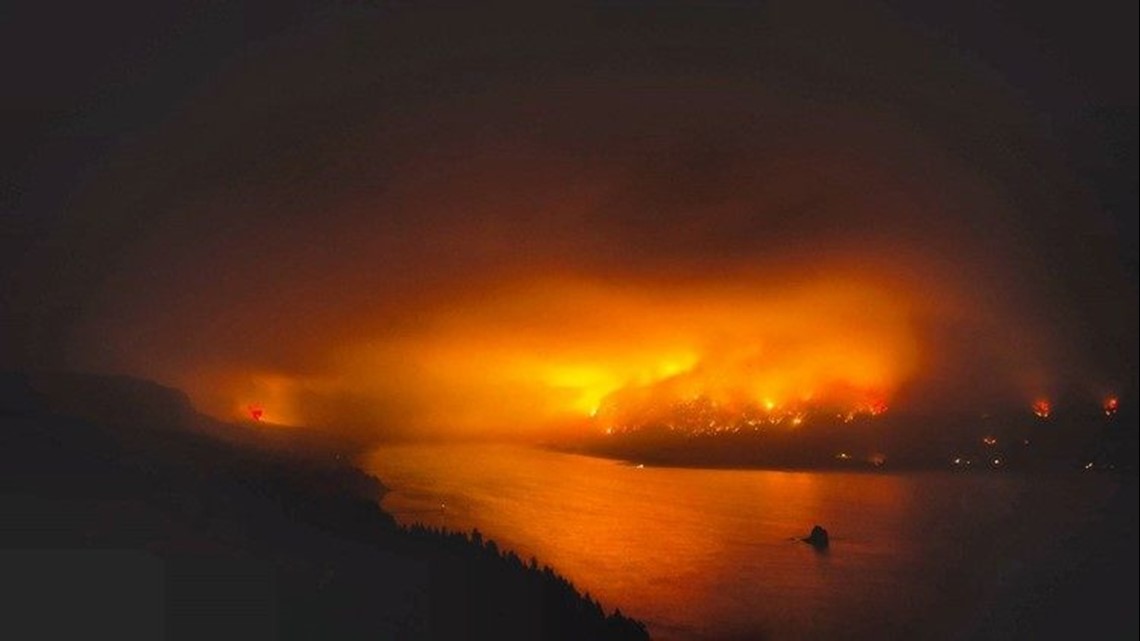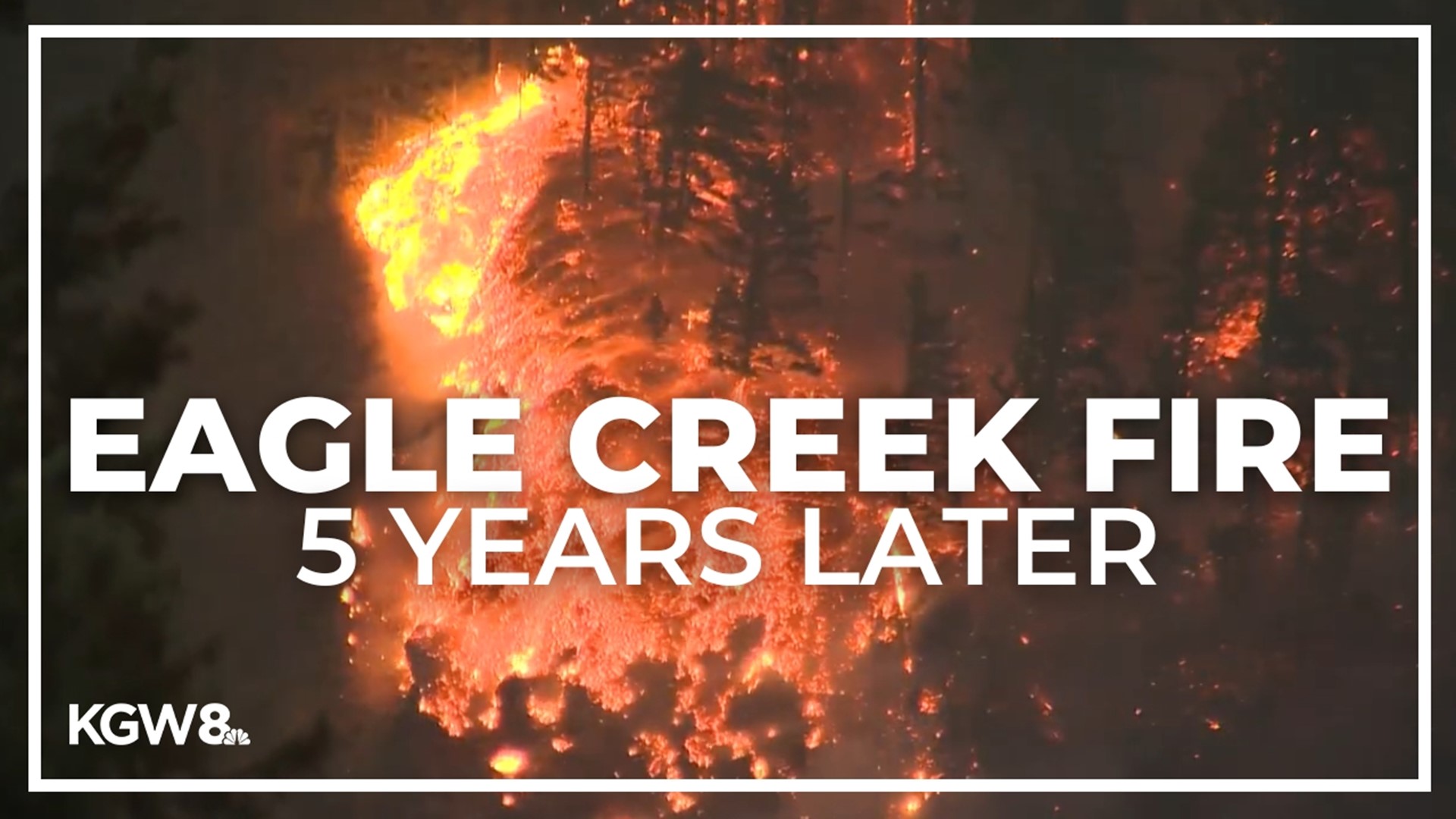CASCADE LOCKS, Ore. — Five years ago, a teenage boy playing with fireworks ignited a wildfire in the Columbia River Gorge that burned more than 48,000 acres, an area nearly the size of Salem and Eugene combined, over the course of three months and left a long-lasting mark on one of the most popular outdoor recreation areas in the Pacific Northwest.
The Eagle Creek Fire started on Sept. 2, 2017 around 4:30 p.m. It was a windy, hot Saturday afternoon on Labor Day weekend when a Vancouver teen threw a lit firecracker into a ravine off the Eagle Creek Trail near Punch Bowl Falls as other teenagers watched.
Authorities said 152 hikers on the Eagle Creek Trail became trapped as the flames started to spread. Some of them were stuck overnight before first responders rescued them.
By Sunday morning, the fire had burned about 3,000 acres as it approached the town of Cascade Locks. The town was evacuated as the fire gained strength, and westerly winds sent a haze of smoke over the greater Portland area.
The fire had grown to 10,000 acres by the following Tuesday, traveling 13 miles in just 16 hours. East of Portland, 30 miles of Interstate 84 were shut down. The fire jumped the Columbia River into Washington and grew dangerously close to the Multnomah Falls Lodge. Roughly 400 homes in the Gorge were evacuated.
The Eagle Creek Fire was declared 100% contained by the end of November 2017, but parts of the forest were still smoldering nine months after it began.
The aftermath
The popular Eagle Creek Trail remained closed for more than three years after the fire. It finally reopened in July 2021. Countless other trails were impacted, and if you explore the Gorge or many parts of the Mount Hood National Forest, you'll find acres upon acres of burned trees.
A six-mile stretch of the Historic Columbia River Highway was closed from Bridal Veil to Ainsworth State Park until November 2018. About 9,000 trees in danger of falling on the road were cut and more than 3,000 feet of protective fencing was installed before it was deemed safe to reopen, according to the Oregon Department of Transportation.
In February 2018, a judge sentenced the teen who started the fire to five years probation and 1,920 hours of community service with the Forest Service. The following May, the court ordered him to pay $36.6 million in restitution. If he completes his community service within 10 years, his restitution may be wiped away.
Five years later
Chris Harper is an assistant fire management officer with the U.S. Forest Service. We caught up with him to take a look at how the Eagle Creek recreation area has recovered since the wildfire.
"I mean immediately after the fire, all this vegetation was gone. With the exception of the large trees that survived the fire, this would have all been black," said Harper. "Pretty much everything was consumed."
He said he's been thinking about the loss of vegetation since the fire first started.
While you'll notice plenty of dead trees waiting for time and gravity to fall, others are flourishing in new patches of sunlight made available by the burned canopy above.
"You get big trees that have a lot of bark and were tall enough to avoid a lot of the heat from the fire and were able to survive. You know, a lot of trees died. But a lot of trees were able to live through the fire," said Harper.
Kim Owen, who moved out to Mosier just to be closer to the beautiful hiking trails of the Gorge, said he remembers a mix of feelings as the fire raged.
"It was really terrifying and just saddening. It was a tragedy that our favorite hiking area was decimated so heavily during that fire," said Owen.


Owen is part of the Pacific Crest Trail Association, which helped repair fire damage and move boulders and rocks off the trail in the months that followed the Eagle Creek Fire. This week, he hiked along part of the trail that he hadn't visited since the burn.
"I’m amazed. Other than a few dead trees you can hardly tell there was a burn.”
Nadia Grey and Daniil Fasahov were out exploring a trail with their two dogs this week. Grey said she grew up going on hikes in the Gorge with her dad.
"I was heartbroken," she said of the Eagle Creek Fire. "I knew it would take a long recovery. It was something really special and, whether you want to call it an accident or what, it was human ignorance. And it shows just how incredibly delicate this space is, and it needs to be treated respectfully.”
Five years after the worst fire the area has seen in modern times, there are still burned stumps and trees with black bark along the Eagle Creek Trail, yet the ground is once again teeming with plants.
"It's so refreshing to be out here now. And I think people have learned that you can’t take it for granted. Everyone’s a little more polite on the trail – everyone’s giving each other a little more space. I’m seeing less damage to the trail. People aren’t littering as much. And I’m so glad that its back," said Grey.
Harper said he too is joyful for the return of life and a new beginning.
"The fire wasn’t an end point, you know. Its not something that destroyed the Gorge or anything like that. It changed it, and changed it in pretty significant ways, but the Gorge is still here and the vegetation will grow back, and there's still lots of beautiful things to see here. So it was a big impact and it changed a lot of stuff, but it didn’t destroy anything necessarily.”

